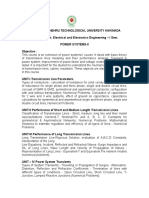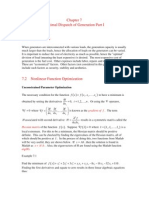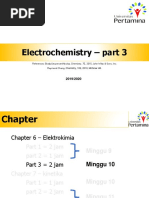9032 Experiment 02
9032 Experiment 02
Uploaded by
sweetu_adit_eeCopyright:
Available Formats
9032 Experiment 02
9032 Experiment 02
Uploaded by
sweetu_adit_eeCopyright
Available Formats
Share this document
Did you find this document useful?
Is this content inappropriate?
Copyright:
Available Formats
9032 Experiment 02
9032 Experiment 02
Uploaded by
sweetu_adit_eeCopyright:
Available Formats
Electrical Measurements (9032)
Experiment No. 2
EXPERIMENT NO. 2
1.0 TITLE :
a) b) To measure high value of D. C. current by a Low range D. C. Ammeter and Shunt. To measure high value of D. C. voltage by a Low range D. C. Voltmeter and Multiplier.
Part B :To study the constructional details of Permanent Magnet Moving Coil and Moving Iron Instruments.
2.0
PRIOR CONCEPTS:
P. M. M. C. instrument.
3.0
NEW CONCEPTS
Proposition 1 : High value of Current and Voltage. High value of current means the current exceeding the safe working current of the particular instrument. Similarly High value of voltage means the voltage exceeding the safe working voltage of the particular instrument. Concept Structure 1 :
Proposition 2 : Range of the instrument (measurement capacity) Range, also called as full scale deflection (FSD) of the instrument is the maximum permissible value of current or voltage that the instrument can measure and it is limited by the current which the coil of the instrument can carry safely. For example, the coil and spiral springs of the P. M. M. C. instrument are very delicate and are normally designed for maximum current of only about 50 milli - amperes and a potential drop of about 50 milli - volts. But the instrument (Ammeter or Voltmeter) is often required to measure value more than its Range i.e. measurement capacity. i.e. it is required to measure High value of D. C. current by a Low range D. C. Ammeter. Similarly, High value of D. C. voltage by a Low range D. C. voltmeter.
14
MAHARASHTRA STATE BOARD OF TECHNICAL EDUCATION
Electrical Measurements (9032)
Experiment No. 2
Concept Structure 2 :
Proposition 3 : Measurement of high value of D. C. current. The current carrying capacity of a D. C. ammeter depends upon the resistance of the coil of the particular instrument. So for a Low range D. C. Ammeter, to measure a high value of D. C. current, its resistance should be reduced, which is done with the help of a device called 'shunt'. 'Shunt is a low resistance, necessarily lower than the instrument and it is connected in parallel with Ammeter (i.e.) instrument coil. Thus a low range D. C. Ammeter with the help of 'Shunt' can measure high value of D. C. current. Concept Structure 3 :
Proposition 4 : Shunt resistance. A low range D. C. Ammeter with resistance r ohms and maximum safe working current (full scale deflection) I amp, can measure the high current of I amp with the help of Shunt of resistance Rsh given by Rsh = r / (M 1) ohms Where M = Multiplying Power of Shunt = I / i Concept Structure 4 : with the help of
Proposition 5 : Measurement of high value of D. C. voltage. The current carrying capacity of D. C. voltmeter also depends upon the resistance of the coil of the particular instrument. So for a low range D. C. voltmeter, to measure a high value of D. C. voltage, its resistance should be increased, which is done with the help of a device called 'multiplier'.
MAHARASHTRA STATE BOARD OF TECHNICAL EDUCATION
15
Electrical Measurements (9032)
Experiment No. 2
'Multiplier' is a high resistance and it is connected in series with the instrument coil. Thus a low range D. C. voltmeter with the help of 'multiplier' can measure high value of D. C. voltage. Concept Structure 5 :
Proposition 6 : Multiplier resistance A low range D. C. voltmeter of resistance 'r' ohms and maximum safe working voltage (full scale deflection) 'v' volts, can measure the high voltage of 'V' votls with the help of 'Multiplier' of resistance Rse given by Rse = r (M - 1) ohms Where M = Multiplying Power of 'Multiplier' = V / v. Concept Structure 6 :
4.0
LEARNING OBJECTIVES:
Intellectual Skills: To understand the concept of shunt and multiplier. To calculate values of Rsh of 'Shunt' for measurement of high values of current that a low range ammeter is expected to measure. To calculate values of Rse of 'Multiplier' for measurement of high values of voltage that a low range voltmeter is expected to measure. To interpret the results. Motor Skills Ability to connect the circuit. Ability to read, record the meters and observe the use of Shunt and Multiplier.
5.0
CIRCUIT DIAGRAM :
Part A : To measure high value of D. C. current by Low range D. C. Ammeter and Shunt.
16
MAHARASHTRA STATE BOARD OF TECHNICAL EDUCATION
Electrical Measurements (9032)
Experiment No. 2
Part B : To measure high value of D. C. voltage by Low range D. C. Voltmeter and Multiplier.
6.0
APPARATUS :
Ammeter - A low range ammeter (0-1A , D. C.) and shunt , Ammeter of 0-10A D.C. Voltmeter - V low range voltmeter (0-15V, D. C.) and Multiplier, Voltmeter of 0-300V D.C. Potential Divider Load up to 10Amp Digital Multimeter.
7.0
STEPWISE PROCEDURE :
Part A : 1. 2. 3. 4. 5. 6. 7. 8. 1. 2. Measure resistance of low range ammeter. Calculate value of shunt resistance Rsh so that the low range ammeter can measure 10 amp. Connect the low range ammeter and shunt in parallel with each other. Connect the circuit as shown in circuit diagram of Part A. Switch on the supply. Increase current 'I' in steps to 2, 4, 6, 8, 10 Amp and note down 'i'. Find multiplying power of 'Shunt'. Switch off the supply. Measure resistance of low range voltmeter. Calculate value of multiplier resistance Rse so that the low range voltmeter can measure 300 volts.
Part B :
MAHARASHTRA STATE BOARD OF TECHNICAL EDUCATION
17
Electrical Measurements (9032)
Experiment No. 2
3. 4. 5. 6. 7. 8. 9.
Connect the low range voltmeter and multiplier in series with each other. Connect the circuit as shown in circuit diagram of part B. Keep potential divider to such position that minimum voltage is applied to the circuit initially. Switch on the supply. Increase voltage 'V' in steps to 50, 100, 150, 200, 230 Volts and note down 'v'. Find multiplying power of Multiplier. Switch off the supply.
8.0
OBSERVATIONS :
Part A: To measure high value of D. C. current by a low range D. C. Ammeter and shunt. Observation for different currents
Part B : To measure high value of D. C. voltage by a low range D. C. Voltmeter and Multiplier. Observation for different voltages.
9.0
CALCULATIONS :
I M = Multiplying Power of 'Shunt' = i V M = Multiplying Power of 'Multiplier' = v
10.0 CONCLUSION :
(Write conclusion by selecting appropriate word from the bracket) A (high / low) range DC Ammeter, with the help of 'Shunt' can measure . (low / high) value of current. The . (same / different) instrument (DC Ammeter) can be used to measure DC currents of different ranges by employing (same / different) shunts.
18
MAHARASHTRA STATE BOARD OF TECHNICAL EDUCATION
Electrical Measurements (9032)
Experiment No. 2
A (high / low) range DC voltmeter, with the help of 'Multiplier' can measure (low / high) value of voltage. The . (same / different) instrument DC Voltmeter can be used to measure DC voltmeters of different ranges by employing (same / different) Multipliers
11.0 QUESTIONS :
Write answers to QQQQ (Question numbers are to allotted by the teacher) 1. What is the meaning of 'High Value'? 2. What is meant by 'Range' of an instrument? 3. What is the main factor deciding 'Range' of P. M. M. C. instrument? 4. Why it is necessary to increase the range of a DC Ammeter and Voltmeter? 5. What are the properties of Shunts and Multipliers? 6. What is the advantage of using 'Shunt' and 'Multiplier'? 7. How the range of a given Ammeter is extended to 75 Amp D.C.? 8. How to convert a given Voltmeter into 0-75-150-300 Volts DC Voltmeter? 9. Is it possible to use Shunt and Multiplier for measurement of high values of A. C. current and voltage measurements respectively? Give reason.
(Space for answers)
MAHARASHTRA STATE BOARD OF TECHNICAL EDUCATION
19
Electrical Measurements (9032)
Experiment No. 2
(Space for answer)
Signature of Teacher
20
MAHARASHTRA STATE BOARD OF TECHNICAL EDUCATION
You might also like
- Electrical Engineering Resume Third Year CombinationNo ratings yetElectrical Engineering Resume Third Year Combination2 pages
- Basic Electrical Laboratory Manual: Department of Electrical EngineeringNo ratings yetBasic Electrical Laboratory Manual: Department of Electrical Engineering42 pages
- EEE 458 - Power System Protection LaboratoryNo ratings yetEEE 458 - Power System Protection Laboratory12 pages
- Lab Manual-Electrical Instrumentaion and Measrement0% (1)Lab Manual-Electrical Instrumentaion and Measrement28 pages
- Isolation and Protection of The Motor-Generator Pair System For Fault Ride-Through of Renewable Energy Generation SystemsNo ratings yetIsolation and Protection of The Motor-Generator Pair System For Fault Ride-Through of Renewable Energy Generation Systems20 pages
- Difference Between Power and Small Signal DiodeNo ratings yetDifference Between Power and Small Signal Diode4 pages
- Hybrid and Smart Energy Management System Using ArduinoNo ratings yetHybrid and Smart Energy Management System Using Arduino4 pages
- Triangular Wave Generator Using Op Amp - WaveformsNo ratings yetTriangular Wave Generator Using Op Amp - Waveforms6 pages
- "Bridge B2HZ" For The Control of A DC MotorNo ratings yet"Bridge B2HZ" For The Control of A DC Motor16 pages
- Direct - Indirect - Regenerative Method of TestingNo ratings yetDirect - Indirect - Regenerative Method of Testing29 pages
- Minimizing Penalty in Industrial Power Consumption by Engaging APFC UnitNo ratings yetMinimizing Penalty in Industrial Power Consumption by Engaging APFC Unit5 pages
- Measurement and Instrumentation Lab ManualNo ratings yetMeasurement and Instrumentation Lab Manual3 pages
- Experiment No.: Aim: - To Measure Three Phase Power and Power Factor in A Balanced Three Phase Circuit UsingNo ratings yetExperiment No.: Aim: - To Measure Three Phase Power and Power Factor in A Balanced Three Phase Circuit Using5 pages
- Topics To Be Discussed: - Voltmeter Sensitivity. - Voltmeter LoadingNo ratings yetTopics To Be Discussed: - Voltmeter Sensitivity. - Voltmeter Loading90 pages
- DC Motor: Torque of DC Motor Torque Equation of DC MotorNo ratings yetDC Motor: Torque of DC Motor Torque Equation of DC Motor4 pages
- Applications of Power Electronics To Power SystemsNo ratings yetApplications of Power Electronics To Power Systems8 pages
- MD Singh Power Electronics Solution Manual To Chapter 13100% (1)MD Singh Power Electronics Solution Manual To Chapter 132 pages
- Three Phase Fault Analysis With Auto Reset Technology On Temporary Fault or Remain Tripped Otherwise50% (2)Three Phase Fault Analysis With Auto Reset Technology On Temporary Fault or Remain Tripped Otherwise4 pages
- Syllabus-MTech-Digital Protection Power SystemNo ratings yetSyllabus-MTech-Digital Protection Power System3 pages
- Experiment # 09: Objective: To Study The Over Voltage Protection of DC Power Supply System (CLO 1) Apparatus100% (1)Experiment # 09: Objective: To Study The Over Voltage Protection of DC Power Supply System (CLO 1) Apparatus20 pages
- Power System Analysis and Simulation Question Paper100% (1)Power System Analysis and Simulation Question Paper2 pages
- Exp 2 - EEM - Dielectric Strength of Solid Insulating MaterialNo ratings yetExp 2 - EEM - Dielectric Strength of Solid Insulating Material5 pages
- 2. Voltage Regulation of Synchronous GeneratorsNo ratings yet2. Voltage Regulation of Synchronous Generators8 pages
- P.F. & P.F Improvement of Using CapacitorNo ratings yetP.F. & P.F Improvement of Using Capacitor3 pages
- Developing Counter and Time Delay RoutineNo ratings yetDeveloping Counter and Time Delay Routine24 pages
- Computer Aided Transient Stability AnalysisNo ratings yetComputer Aided Transient Stability Analysis5 pages
- Types of Energy Meters and Their Working PrinciplesNo ratings yetTypes of Energy Meters and Their Working Principles5 pages
- Familiarization of Electronic Measuring Instruments0% (1)Familiarization of Electronic Measuring Instruments9 pages
- Design of Electrical Circuits using Engineering Software ToolsFrom EverandDesign of Electrical Circuits using Engineering Software ToolsNo ratings yet
- Control of Indirect Matrix Converter Under Unbalanced Source Voltage and Load Current ConditionsNo ratings yetControl of Indirect Matrix Converter Under Unbalanced Source Voltage and Load Current Conditions7 pages
- Ignition Systems: Point Style (Conventional) & Electronic StylesNo ratings yetIgnition Systems: Point Style (Conventional) & Electronic Styles27 pages
- Optimal Dispatch of Generation Part I: Unconstrained Parameter OptimizationNo ratings yetOptimal Dispatch of Generation Part I: Unconstrained Parameter Optimization9 pages
- Wiener Filter Design in Power Quality ImprovmentNo ratings yetWiener Filter Design in Power Quality Improvment8 pages
- 6.013 Electromagnetics and Applications: Mit OpencoursewareNo ratings yet6.013 Electromagnetics and Applications: Mit Opencourseware13 pages
- Laser Vapour Deposition & Plasma Enhanced DepositionNo ratings yetLaser Vapour Deposition & Plasma Enhanced Deposition21 pages
- ABB REL670 V1.B A32 Template Manual ENU TU3.00 V1.000 PDFNo ratings yetABB REL670 V1.B A32 Template Manual ENU TU3.00 V1.000 PDF17 pages
- Features General Description: High Performance Current Mode PWM ControllerNo ratings yetFeatures General Description: High Performance Current Mode PWM Controller8 pages
- 6ra80 Mit Motoren Parallel Oder Seriell 76No ratings yet6ra80 Mit Motoren Parallel Oder Seriell 763 pages
- Auto Voltage Regulator (PVR Series500VA-10KVA)No ratings yetAuto Voltage Regulator (PVR Series500VA-10KVA)2 pages
- EVS93xx - 9300 Servo 15-30kW - v3-0 - ENNo ratings yetEVS93xx - 9300 Servo 15-30kW - v3-0 - EN46 pages
- Ref1A High-Impedance Based Restricted Earth-Fault ProtectionNo ratings yetRef1A High-Impedance Based Restricted Earth-Fault Protection19 pages
- B. Mahesh Babu, L. Ravi Srinivas T. Karunakar A. Amarendra Duvvuru Sreenadh Reddy M. Ramu J.N.V.R.Swarup Kumar S. S. Tulasi Ram Regular PaperNo ratings yetB. Mahesh Babu, L. Ravi Srinivas T. Karunakar A. Amarendra Duvvuru Sreenadh Reddy M. Ramu J.N.V.R.Swarup Kumar S. S. Tulasi Ram Regular Paper12 pages
- Analogue Design Journal - Texas InstumentsNo ratings yetAnalogue Design Journal - Texas Instuments13 pages
- NMR Monographs: (See Also The Separate List Of)No ratings yetNMR Monographs: (See Also The Separate List Of)42 pages
- Motor Operating Device UEMC 50: Installation, Operating and Recycling GuideNo ratings yetMotor Operating Device UEMC 50: Installation, Operating and Recycling Guide40 pages
- Electronic Device Lab 1 Diode CharacteristicsNo ratings yetElectronic Device Lab 1 Diode Characteristics9 pages
- Electrical Engineering Resume Third Year CombinationElectrical Engineering Resume Third Year Combination
- Basic Electrical Laboratory Manual: Department of Electrical EngineeringBasic Electrical Laboratory Manual: Department of Electrical Engineering
- Lab Manual-Electrical Instrumentaion and MeasrementLab Manual-Electrical Instrumentaion and Measrement
- Isolation and Protection of The Motor-Generator Pair System For Fault Ride-Through of Renewable Energy Generation SystemsIsolation and Protection of The Motor-Generator Pair System For Fault Ride-Through of Renewable Energy Generation Systems
- Hybrid and Smart Energy Management System Using ArduinoHybrid and Smart Energy Management System Using Arduino
- Triangular Wave Generator Using Op Amp - WaveformsTriangular Wave Generator Using Op Amp - Waveforms
- Direct - Indirect - Regenerative Method of TestingDirect - Indirect - Regenerative Method of Testing
- Minimizing Penalty in Industrial Power Consumption by Engaging APFC UnitMinimizing Penalty in Industrial Power Consumption by Engaging APFC Unit
- Experiment No.: Aim: - To Measure Three Phase Power and Power Factor in A Balanced Three Phase Circuit UsingExperiment No.: Aim: - To Measure Three Phase Power and Power Factor in A Balanced Three Phase Circuit Using
- Topics To Be Discussed: - Voltmeter Sensitivity. - Voltmeter LoadingTopics To Be Discussed: - Voltmeter Sensitivity. - Voltmeter Loading
- DC Motor: Torque of DC Motor Torque Equation of DC MotorDC Motor: Torque of DC Motor Torque Equation of DC Motor
- Applications of Power Electronics To Power SystemsApplications of Power Electronics To Power Systems
- MD Singh Power Electronics Solution Manual To Chapter 13MD Singh Power Electronics Solution Manual To Chapter 13
- Three Phase Fault Analysis With Auto Reset Technology On Temporary Fault or Remain Tripped OtherwiseThree Phase Fault Analysis With Auto Reset Technology On Temporary Fault or Remain Tripped Otherwise
- Experiment # 09: Objective: To Study The Over Voltage Protection of DC Power Supply System (CLO 1) ApparatusExperiment # 09: Objective: To Study The Over Voltage Protection of DC Power Supply System (CLO 1) Apparatus
- Power System Analysis and Simulation Question PaperPower System Analysis and Simulation Question Paper
- Exp 2 - EEM - Dielectric Strength of Solid Insulating MaterialExp 2 - EEM - Dielectric Strength of Solid Insulating Material
- Types of Energy Meters and Their Working PrinciplesTypes of Energy Meters and Their Working Principles
- Familiarization of Electronic Measuring InstrumentsFamiliarization of Electronic Measuring Instruments
- Design of Electrical Circuits using Engineering Software ToolsFrom EverandDesign of Electrical Circuits using Engineering Software Tools
- Control of Indirect Matrix Converter Under Unbalanced Source Voltage and Load Current ConditionsControl of Indirect Matrix Converter Under Unbalanced Source Voltage and Load Current Conditions
- Ignition Systems: Point Style (Conventional) & Electronic StylesIgnition Systems: Point Style (Conventional) & Electronic Styles
- Optimal Dispatch of Generation Part I: Unconstrained Parameter OptimizationOptimal Dispatch of Generation Part I: Unconstrained Parameter Optimization
- 6.013 Electromagnetics and Applications: Mit Opencourseware6.013 Electromagnetics and Applications: Mit Opencourseware
- Laser Vapour Deposition & Plasma Enhanced DepositionLaser Vapour Deposition & Plasma Enhanced Deposition
- ABB REL670 V1.B A32 Template Manual ENU TU3.00 V1.000 PDFABB REL670 V1.B A32 Template Manual ENU TU3.00 V1.000 PDF
- Features General Description: High Performance Current Mode PWM ControllerFeatures General Description: High Performance Current Mode PWM Controller
- Ref1A High-Impedance Based Restricted Earth-Fault ProtectionRef1A High-Impedance Based Restricted Earth-Fault Protection
- B. Mahesh Babu, L. Ravi Srinivas T. Karunakar A. Amarendra Duvvuru Sreenadh Reddy M. Ramu J.N.V.R.Swarup Kumar S. S. Tulasi Ram Regular PaperB. Mahesh Babu, L. Ravi Srinivas T. Karunakar A. Amarendra Duvvuru Sreenadh Reddy M. Ramu J.N.V.R.Swarup Kumar S. S. Tulasi Ram Regular Paper
- Motor Operating Device UEMC 50: Installation, Operating and Recycling GuideMotor Operating Device UEMC 50: Installation, Operating and Recycling Guide
































































































